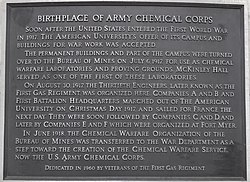| Camp Leach | |
|---|---|
| Part of American University | |
| Washington, D.C. | |
 This sign at American University in Washington, D.C. commemorates the establishment of the U.S. Army Chemical Corps in June 1918. This sign at American University in Washington, D.C. commemorates the establishment of the U.S. Army Chemical Corps in June 1918. | |
 | |
| Coordinates | 38°56′8.98″N 77°5′21.54″W / 38.9358278°N 77.0893167°W / 38.9358278; -77.0893167 |
| Type | Temporary camp |
| Area | 11 acres (4.5 ha) |
| Site information | |
| Owner | War Department |
| Operator | Chemical Warfare Service |
| Controlled by | Corps of Engineers |
| Site history | |
| In use | 1917–1919 |
| Fate | Abandoned, ordered salvaged |
| Battles/wars | World War I |
Camp Leach, formerly known as the American University Experimental Station and Camp American University, was a World War I era United States Army camp built by the Corps of Engineers on American University property in Washington, D.C. It was named in honor of Colonel Smith S. Leach, Corps of Engineers. The camp was established in 1917 for the organization of engineer units and subsequently used by the Chemical Warfare Service. Abandoned in January 1919, it was ordered salvaged.
History
During World War I, American University allowed the United States Army to use part of its campus for weapons development and testing. In 1917, 24 days after the U.S. declared war on Germany, the school offered its property to the war effort. The military activities at American University (i.e. Chemical warfare experiment station; Pharmacological Research Section and Pathology Section of Medical Division, Chemical Warfare Service; and Camp Leach) were considered at the time to be "the largest laboratory this side of the sun or other burning stars." Thus, American University became the birthplace of the United States' chemical weapons program. About 100,000 soldiers and 2,000 chemists were employed on campus. What is now Spring Valley was an undeveloped area on campus where the Army was allowed to use for testing chemical weapons, such as mustard gas.
At the far corner of American University, the United States Army also tested some of its weapons. When the war ended it was reported that $800,000 (in 1918-dollars) worth of World War I munitions were buried in a pit in the same corner of the university.
Environmental impact
In 1993, during excavations of a utility trench, construction workers found unexploded ordnance, and scientists found high levels of arsenic in the soil. The next day it was reported in The Washington Post that World War I bomb shells had been unearthed near a senator's house bordering the campus. This touched off a cleanup effort by the Environmental Protection Agency and the Corps of Engineers who called it the Spring Valley Formerly Used Defense Site. This cleanup lasted nearly two years.
In 2003 many more dangerous sites in the area were uncovered, including perchlorate in groundwater and three burial pits on grounds of the South Korean ambassador's residence. In 2005 the Agency for Toxic Substances and Disease Registry issued a "Health Consultation"' and two years later Johns Hopkins University was contracted for a health study. The site, which included a corner of American University and several neighboring residences, including the residence of the Embassy of South Korea, which occupies a significant percentage of the site. As no buildings have been built directly atop the site, the Corps of Engineers announced that the effects of neither the residual chemicals nor the cleanup program will have any effects on the students.
See also
References
- Emery, Theo (November 10, 2018). "The Chemists' War". The New York Times.
- Weil, Martin; O'Donnell, Santiago (January 6, 1993). "WWI Munitions Unearthed At D.C. Construction Site". The Washington Post.
- "Baltimore District. Spring Valley Overview". U.S. Army Corps of Engineers (USACE). February 2014. Retrieved March 26, 2014.
- Emery, Theo (March 18, 2012). "Zeroing in on the Mystery of an Old Site Called Hades". The New York Times.
- "Washington, D.C. Army Chemical Munitions (Spring Valley)". Region 3 Superfund sites. Environmental Protection Agency. February 2014. Retrieved March 26, 2014.
- Augenstein, Neil (May 19, 2017). "As WWI munitions cleanup nears end, mysterious find pauses project". WTOP-FM.
Further reading
- "Camp Leach: When Chemical Weapons Were Made at American University". Ghosts of DC. November 19, 2019.
- "Digging up the dirt from World War I". American Weekly. August 20, 2004. Archived from the original on August 20, 2004 – via Wayback Machine.
- 1917 establishments in Washington, D.C.
- 1919 disestablishments in Washington, D.C.
- Buildings and structures demolished in 1919
- Chemical warfare facilities
- Former training facilities of the United States Army
- Demolished buildings and structures in Washington, D.C.
- History of American University
- Military camps in the United States
- Military installations closed in 1919
- United States Army posts
- United States home front during World War I
- World War I sites in the United States